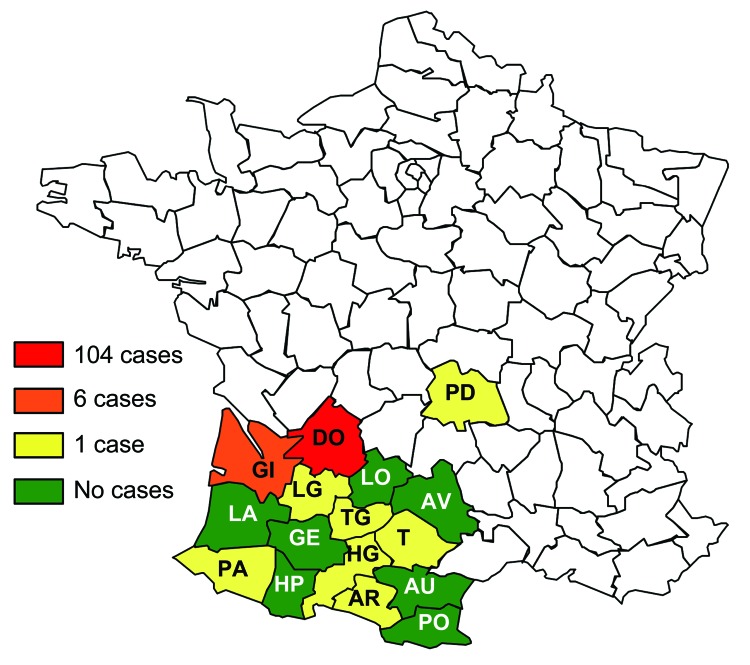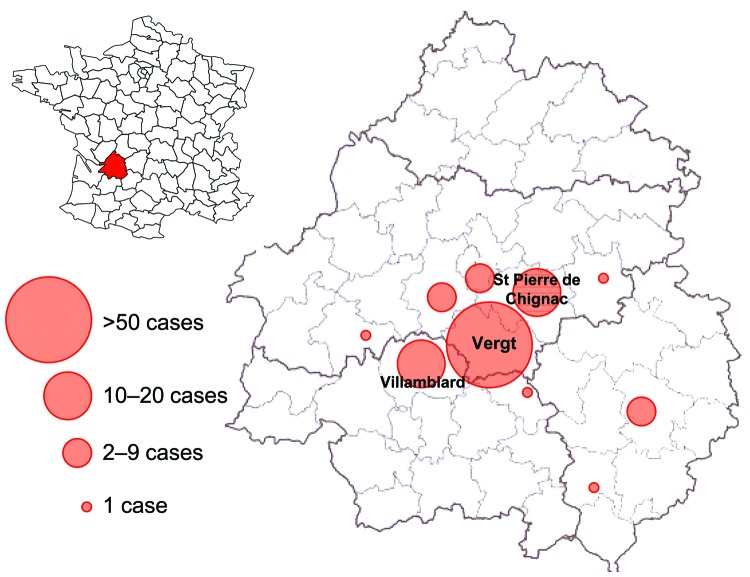Abstract
During 2005–2008, veterinary practitioners reported ocular infection by Thelazia spp. nematodes in 115 dogs and 2 cats in southwestern France. Most cases were detected in Dordogne, particularly in 3 counties with numerous strawberry farms, which may favor development of the fruit fly vector. Animal thelaziosis may lead to emergence of human cases.
Keywords: Thelazia callipaeda, ocular thelaziosis, France, parasites, parasitic diseases, Dordogne, dog, eyes, dispatch
Thelazia spp. (Spirurida, Thelaziidae) nematodes live in the conjunctival sac of warm-blooded vertebrates. These nematodes are responsible for epiphora, conjunctivitis, keratitis, and corneal ulcers (1–3). Thelazia spp. nematodes are transmitted by different species of flies feeding from the lacrimal secretions of the definitive hosts. Among the 10 species, T. californiensis and T. callipaeda parasitize carnivores and sometimes humans. T. californiensis is confined to the western United States and has never been reported in Europe (1). T. callipaeda, the “oriental eye worm,” is common in the former Soviet republics and in India, Thailand, People’s Republic of China, and Japan (2), where it causes infections in humans, dogs, and cats (3). Wild mammals, such as foxes and lagomorphs, are reservoir hosts for the nematodes. During the past decade T. callipaeda infection was proven to be widespread among dogs and cats from northern (Aosta valley) to southern (Basilicata region) Italy (4). In Ticino, a region of southern Switzerland, a retrospective study identified 106 T. callipaeda–positive dogs and 5 positive cats during 2005–2007 (5). Recently, the first autochthonous case of thelaziosis in a dog was described in southern Germany (6). Locally transmitted cases of thelaziosis were first reported in 4 dogs and 1 cat that lived or spent time in the department of Dordogne in southwestern France (7).
The Study
At the end of 2008, we contacted veterinary practitioners from 938 veterinary practices in 16 departments in France by regular mail. The survey covered a large part of southwestern France (Figure 1), where the first thelaziosis cases in dogs and cats were reported in 2007 (7). Veterinary practitioners were asked whether they had diagnosed ocular thelaziosis in a dog or a cat during the previous 3 years. For each clinical case, a short questionnaire asked for a description of the animal (i.e., sex, age, breed, use), description of the place where the animal lived, and treatment protocol.
Figure 1.
Departments in which the epidemiologic survey for thelaziosis was conducted and number of cases of canine and feline thelaziosis, France, 2005–2008. Clinical cases of thelaziosis were reported in 9 departments. PO, Pyrénées-orientales; AR, Ariège; AU, Aude; AV, Aveyron; DO, Dordogne; GE, Gers; GI, Gironde; HG, Haute-Garonne; HP, Hautes-Pyrénées; LA, Landes; LG, Lot-et-Garonne; LO, Lot; PA, Pyrénées-Atlantiques; PD, Puy-de-Dôme; T, Tarn; TG, Tarn-et-Garonne.
A total of 117 clinical cases of thelaziosis (115 dogs and 2 cats) was reported in 22 veterinary practices from 9 departments (Ariège, Dordogne, Gironde, Haute-Garonne, Lot-et-Garonne, Puy-de-Dôme, Pyrénées-Atlantiques, Tarn, and Tarn-et-Garonne). Most (104 [89%]) cases were diagnosed from 10 practices in Dordogne (Figure 1). In each of the other departments, only a few (1–6) cases were diagnosed. Furthermore, most of the infected animals in other departments had spent time in Dordogne a few months before clinical signs developed. In Dordogne, most cases were from the center of the department, with 3 counties overrepresented (60 cases in Vergt, 16 cases in Saint-Pierre-de-Chignac, and 9 cases in Villamblard) (Figure 2). In these counties, strawberry production is predominant and may favor development of the fruit fly vector, Phortica variegata; in other areas of Dordogne, other types of fruit production (plum or apple) are reported. All infected dogs and the cats were 6 months–14 years of age and privately owned. Ninety-one (78%) of the 117 animals lived in a small village; 22 were farm dogs. Twenty-six animals lived in a city, but all had free access to the outdoors.
Figure 2.
Department of Dordogne (with its 4 arrondissements and 50 counties) and distribution of clinical cases of thelaziosis in dogs and cats, France, 2005–2008. Most cases were reported in the counties of Vergt, Saint Pierre de Chignac, and Villamblard.
The animals were referred to veterinary practitioners for unilateral or bilateral conjunctivitis. For all animals, nematodes were observed on the eye surface. The first cases of thelaziosis were detected in 2 dogs and 1 cat in the county of Vergt at the end of 2005. During 2006, a total of 27 cases were detected in late summer and autumn; animals may have been contaminated by infected vectors during the peak of the male Phortica spp. fly population in summer 2006. During 2007 and 2008, clinical cases were detected throughout the year. The apparent absence of seasonality for detecting adult Thelazia spp. nematodes in definitive hosts is in accordance with previous observations in areas in Italy to which Thelazia spp. nematodes are endemic (8).
Nematodes were collected from the eyes of 19 dogs and 1 cat and morphologically identified according to Skrjabin et al. (9). To determine the haplotype sequence, we processed specimens using the specific amplification of a partial sequence of the mitochondrial cytochrome c oxidase subunit 1 gene (cox1, 605 bp), as previously described (10). The sequences obtained were identical to the sequence representing haplotype 1 of T. callipaeda (GenBank accession no. AM042549) previously reported in Italy and Switzerland but they displayed a 1.3%-nt difference from the haplotype recently detected in Germany (6).
Discussion
Before 2005, thelaziosis had been reported only sporadically in France (11,12), occurring in dogs that had spent time during summer in northern Italy. In 2007, Dorchies et al. described 5 locally transmitted thelaziosis cases from southwestern France (7). The present investigation indicates that Dordogne and, more precisely, the county of Vergt should now be considered as an area to which ocular thelaziosis is endemic. This area is near the Atlantic Ocean and is part of the Aquitaine Region (44°–45°N, ≈0°). Its altitude ranges from 112 m to 246 m, and it has an oceanic climate with an average of 800 mm annual rainfall. This area is at the same latitude as Aosta valley in northern Italy, where thelaziosis in dogs is regularly reported. It belongs to the putative areas in which the drosophilid species P. variegata, the T. callipaeda vector, could be present according to a predictive geoclimatic model in Europe (13).
The T. callipaeda nematode may have been introduced in France by importation or dispersal of vectors and/or reservoir hosts. The dispersal of infected vectors is unlikely because fruit flies are not as robust as other vectors, such as mosquitoes, and are not known to disperse by wind. Introduction by an infected animal seems to be more likely. Adult parasites may have been introduced by a dog (or a small number of dogs) that spent time in a thelaziosis-endemic area in Italy or southern Switzerland during 2005. Another explanation for the introduction of thelaziosis in Dordogne would be migration of infected wild animals (such as foxes) from Switzerland or Italy. However, Dordogne is far from these areas (500 km–600 km) and separated by the Alps. In such circumstances, the possibility of population exchanges is limited. Our final explanation could be the importation of wild hares for hunting in Dordogne. Introduction of infected hares from Italy already has been implicated in outbreaks of animal and human cases of tularemia in Dordogne (14). A recent investigation in southern Italy demonstrated the existence of an active sylvatic life cycle of T. callipaeda nematodes (15). Further studies in the county of Vergt should include investigation of eye worms in wild mammals.
Conclusions
Once introduced in Dordogne, this parasite might have found appropriate conditions for the perpetuation of its life cycle. Our investigation showed that cases in companion animals were located where strawberry production was predominant. T. callipaeda nematodes may be transmitted to humans, and animal thelaziosis in Dordogne may lead to emergence of human cases.
Acknowledgments
We thank Agnès Thibault for financial and technical assistance.
Biography
Dr Ruytoor graduated from the Veterinary College of Alfort, France. Her research interests include the emergence of canine thelaziosis in southwestern France.
Footnotes
Suggested citation for this article: Ruytoor P, Déan E, Pennant O, Dorchies P, Chermette R, Otranto D, et al. Ocular thelaziosis in dogs, France. Emerg Infect Dis [serial on the Internet]. 2010 Dec [date cited]. http://dx.doi.org/10.3201/eid1612.100872
References
- 1.Otranto D, Traversa D. Thelazia eyeworm: an original endo- and ecto-parasitic nematode. Trends Parasitol. 2005;21:1–4. 10.1016/j.pt.2004.10.008 [DOI] [PubMed] [Google Scholar]
- 2.Anderson RC. Nematode parasites of vertebrates: their development and transmission. 2nd ed. Guilford (UK): CABI Publishing; 2000. p. 404–7. [Google Scholar]
- 3.Shen J, Gasser R, Chu D, Wang Z, Yuan X, Cantacessi C, et al. Human thelaziosis—a neglected parasitic disease of the eye. J Parasitol. 2006;92:872–5. 10.1645/GE-823R.1 [DOI] [PubMed] [Google Scholar]
- 4.Otranto D, Ferroglio E, Lia RP, Traversa D, Rossi L. Current status and epidemiological observations of Thelazia callipaeda (Spirurida, Thelaziidae) in dogs, cats and foxes in Italy: a “coincidence” or a parasitic disease of the Old Continent? Vet Parasitol. 2003;116:315–25. 10.1016/j.vetpar.2003.07.022 [DOI] [PubMed] [Google Scholar]
- 5.Malacrida F, Hegglin D, Bacciarini L, Otranto D, Nägeli F, Nägeli C, et al. Emergence of canine ocular thelaziosis caused by Thelazia callipaeda in southern Switzerland. Vet Parasitol. 2008;157:321–7. 10.1016/j.vetpar.2008.07.029 [DOI] [PubMed] [Google Scholar]
- 6.Magnis J, Naucke TJ, Mathis A, Deplazes P, Schnyder M. Local transmission of the eye worm Thelazia callipaeda in southern Germany. Parasitol Res. 2010;106:715–7. 10.1007/s00436-009-1678-4 [DOI] [PubMed] [Google Scholar]
- 7.Dorchies P, Chaudieu G, Siméon LA, Cazalot G, Cantacessi C, Otranto D. First reports of autochtonous eyeworm infection by Thelazia callipaeda (Spirurida, Thelaziidae) in dogs and cat from France. Vet Parasitol. 2007;149:294–7. 10.1016/j.vetpar.2007.08.005 [DOI] [PubMed] [Google Scholar]
- 8.Otranto D, Lia RP, Buono V, Traversa D, Giangaspero A. Biology of Thelazia callipaeda (Spirurida, Thelaziidae) eyeworms in naturally infected definitive hosts. Parasitol. 2004;129:627–33. 10.1017/S0031182004006018 [DOI] [PubMed] [Google Scholar]
- 9.Skrjabin KI, Sobolev AA, Ivashkin VM. Principles of nematology, vol. IX. Spirurata of animals and man and the diseases caused by them. Part 4: Thelazioidea. Izdatel’sto Akademii Nauk SSSR. Washington: Israel Program for Scientific Translations; 1967. [Google Scholar]
- 10.Otranto D, Testini G, Deluca F, Hu M, Shamsi S, Gasser RB. Analysis of genetic variability within Thelazia callipaeda (Nematoda: Thelazioidea) from Europe and Asia by sequencing and mutation scanning of mitochondrial cytochrome c oxidase subunit 1. Mol Cell Probes. 2005;19:306–13. 10.1016/j.mcp.2005.05.001 [DOI] [PubMed] [Google Scholar]
- 11.Bussiéras J, Chermette R. Quelques parasitoses canines exceptionelles en France. II–Un cas de conjonctivite parasitaire du chien, due à Thelazia sp. Prat Méd Chir Anim Comp. 1996;31:83–5. [Google Scholar]
- 12.Chermette R, Guillot J, Bussiéras J. Canine ocular thelaziosis in Europe. Vet Rec. 2004;154:48. [PubMed] [Google Scholar]
- 13.Otranto D, Brianti E, Cantacessi C, Lia RP, Maca J. The zoophilic fruitfly Phortica variegata: morphology, ecology and biological niche. Med Vet Entomol. 2006;20:358–64. 10.1111/j.1365-2915.2006.00643.x [DOI] [PubMed] [Google Scholar]
- 14.Vaissaire J, Mendy C, Le Doujet C, Le Coustumier A. Tularemia. The disease and its epidemiology in France [in French]. Med Mal Infect. 2005;35:273–80. 10.1016/j.medmal.2005.03.005 [DOI] [PubMed] [Google Scholar]
- 15.Otranto D, Dantas-Torres F, Mallia E, DiGeronimo PM, Brianti E, Testini G, et al. Thelazia callipaeda (Spirurida, Thelaziidae) in wild animals: report of new host species and ecological implications. Vet Parasitol. 2009;166:262–7. 10.1016/j.vetpar.2009.08.027 [DOI] [PubMed] [Google Scholar]




